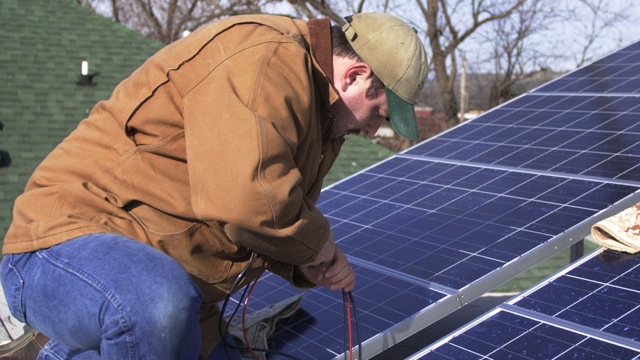
Ben Gerald from Staley Electric Co. helps install solar power panels on the roof of a house in North Little Rock, Arkansas on Jan. 22, 2003. (AP Photo/David Quinn)
The untold story of the 2009 stimulus package is that it jump-started a failing renewable energy sector in the US.
As journalist Michael Grunwald, author The New New Deal: The Hidden Story of Change in the Obama Era, told The Atlantic in 2012, the much-maligned American American Recovery and Reinvestment Act “really launched a silent green revolution.” A big part of that revolution was driven by the stimulus package’s $90 billion for clean energy at a time when the government had been spending only a few billion per year.
Today, many of our green energy subsidies have expired, and additional tax breaks are unlikely to be renewed by Congress. But spending on research and development in both the public and private sector — and by other countries — now appears to be paying dividends. As of last year, the solar energy business alone accounted for more American jobs than gas and coal combined, according to the Solar Foundation’s annual survey.
And, as Diane Cardwell reported this weekend for The New York Times, it appears to be reshaping our energy markets in significant ways.
Cardwell writes:
For the solar and wind industries in the United States, it has been a long-held dream: to produce energy at a cost equal to conventional sources like coal and natural gas.That day appears to be dawning.
The cost of providing electricity from wind and solar power plants has plummeted over the last five years, so much so that in some markets renewable generation is now cheaper than coal or natural gas.
Utility executives say the trend has accelerated this year, with several companies signing contracts, known as power purchase agreements, for solar or wind at prices below that of natural gas, especially in the Great Plains and Southwest, where wind and sunlight are abundant.
Those prices were made possible by generous subsidies that could soon diminish or expire, but recent analyses show that even without those subsidies, alternative energies can often compete with traditional sources.
In Texas, Austin Energy signed a deal this spring for 20 years of output from a solar farm at less than 5 cents a kilowatt-hour. In September, the Grand River Dam Authority in Oklahoma announced its approval of a new agreement to buy power from a new wind farm expected to be completed next year. Grand River estimated the deal would save its customers roughly $50 million from the project.
And, also in Oklahoma, American Electric Power ended up tripling the amount of wind power it had originally sought after seeing how low the bids came in last year.
“Wind was on sale — it was a Blue Light Special,” said Jay Godfrey, managing director of renewable energy for the company. He noted that Oklahoma, unlike many states, did not require utilities to buy power from renewable sources.
“We were doing it because it made sense for our ratepayers,” he said.
According to a study by the investment banking firm Lazard, the cost of utility-scale solar energy is as low as 5.6 cents a kilowatt-hour, and wind is as low as 1.4 cents. In comparison, natural gas comes at 6.1 cents a kilowatt-hour on the low end and coal at 6.6 cents. Without subsidies, the firm’s analysis shows, solar costs about 7.2 cents a kilowatt-hour at the low end, with wind at 3.7 cents.
“It is really quite notable, when compared to where we were just five years ago, to see the decline in the cost of these technologies,” said Jonathan Mir, a managing director at Lazard, which has been comparing the economics of power generation technologies since 2008.
There’s much more to the story. Read the rest at The New York Times.


